That may be how grandmothers handed down recipes through generations, but those who actually watched them would have noticed the nuances. And on Normandy’s Côte Fleurie, where I most recently undertook this endeavor, there was a layering of regional flavors the way the Impressionists layered paint. Which seemed appropriate, because this movement is thought to have begun here, in the late 19th century. The medieval port town of Honfleur, at the mouth of the Seine, and the beach at Trouville-sur-Mer, were favorite subjects of Claude Monet, among others.
The house that my husband, Ken, and I recently rented for a week, about equidistant between the two, was built around the same time. Constructed of red brick and ochre stone, with a gray slate roof, sage-colored shutters and white porches, it was perched on a windswept peak just outside the tiny village of Villerville. Light streamed in from all directions, and west-facing windows looked out at the sea, about 70 miles east of the D-Day beaches. Here the traditional recipe to master was Auge valley chicken, or poulet vallée d’Auge, named for a hilly area about 15 miles south of where we were staying.
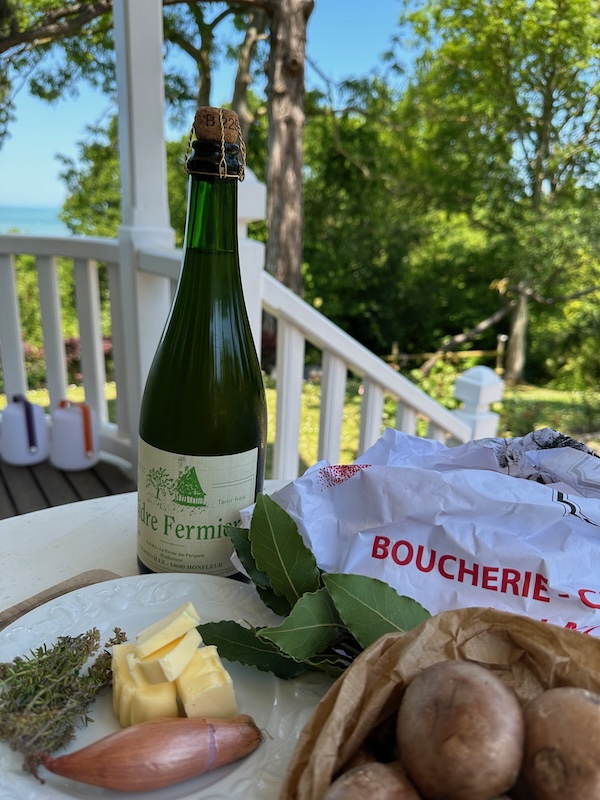
While wine is a key ingredient in other regions, in Normandy the chicken stews in one or two apple-based liquids. A small quantity of Calvados (brandy served as an aperitif) is used to flambé. And a larger measure of hard cider can keep the chicken moist as it bubbles at what the French call à feu doux, or low heat. In a region studded with apple orchards, both were easily procured from La Ferme de Marie – a grocery store in the nearby village of Cricquebœuf. Not surprisingly, the clerk’s broad-brush instructions for stewing the chicken echoed those I’d heard elsewhere in France.
Although others might prefer a break from kitchen chores during foreign travel, cooking with regional and seasonal ingredients is one of my favorite activities in France. Between inflationary food prices and the cost of labor, it has become very difficult to find a good value at restaurants. Increasingly, proprietors skimp on costly ingredients. But those who cook for themselves can choose what goes into the pot, with delicious results.
The French call this terroir – the flavor that food and wine derive from the soil, atmosphere, weather and other factors associated with their production. For example, the apples, berries and fresh vegetables that free-range chickens eat could affect the taste of their meat.
Forage for Ingredients
When I stopped by L’Étal des Fines Bouches, a premium butcher in Trouville-sur-Mer, and asked for a chicken suitable for stewing, the head, neck and feet were still attached to the 1.9-kilo bird held up for my approval. I kept a poker face as the man behind the counter used his cleaver to dispense with the extremities, leaving me roughly four pounds (at $5.30 per pound), cut into eight pieces at my request.
I returned to Trouville-sur-Mer the next day to procure other ingredients at the market, held Sunday and Wednesday mornings along the Touques River. Though there are plenty of supermarkets in France, outdoor markets in small towns and cities offer fresher merchandise and a chance to interact with locals. To learn what’s popular, I routinely join the longest lines and eavesdrop on conversations. And though my halting French quickly brands me as a foreigner, talking about food breaks the ice with merchants and other customers.
“Would you like a bouquet?” the proprietor offered, when I asked for bay leaves at one farmstand. I needed only a few for the bundle of herbs that would go into the pot this time, but the aroma of the fresh leaves was irresistible. She tied up a handful of branches with a string (€1.50, or about $1.60 at current conversion rates). I could add thyme, rosemary and parsley snipped from the garden of our Airbnb, and leave behind some bay leaves for our host. I made two more stops – to buy a single shallot, and 200 grams of cremini mushrooms, before moving on to a stand for farm-fresh eggs and crème fraîche.
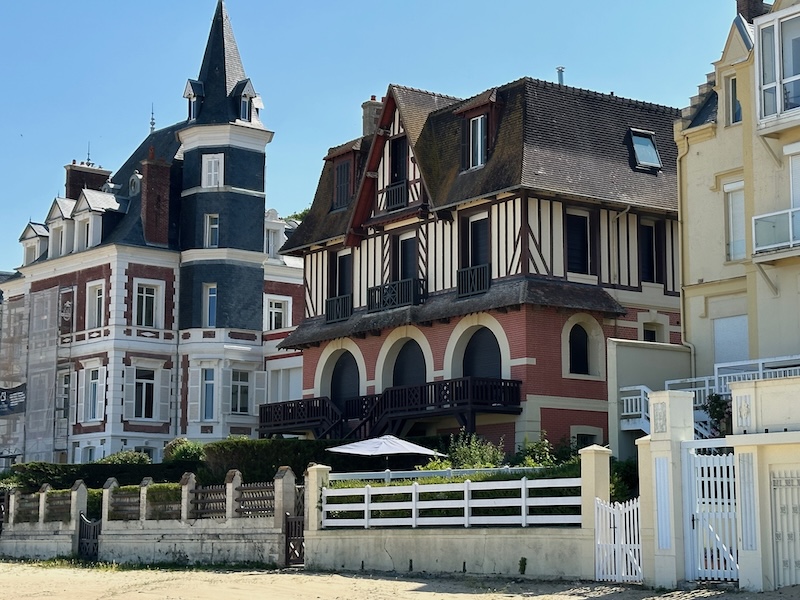
Takeout paella wasn’t on my shopping list, but the weather was glorious, and Trouville’s expansive white sandy beach beckoned for an impromptu picnic. It looked much more elegant in Monet’s paintings from the 1870s, populated by women carrying parasols and men in top hats. But many Victorian villas, like those visible in his paintings, have survived. We would come back another day to meander the city’s historic center, guided by a map procured in the Tourist Office. (“Architectural Walks in the Town” costs €3.50, or about $3.75.) My Sunday afternoon activity, in our well-equipped kitchen, was to stew the chicken.
Don’t Rush the Bird
I’ve learned from past experience not to rush a French free-range chicken (poulet fermier); otherwise, it will come out like rubber. After seasoning the meat with salt and pepper, I melted four tablespoons of Normandy butter in a large, heavy casserole, added a splash of olive oil to prevent it from burning, and sautéed the pieces a few at a time, until they were golden, removing them to a plate as they were finished. While this was happening, I peeled and chopped the shallot that would be added to the empty casserole and cooked for a couple of minutes until aromatic and translucent.
The next step, the flambé, is the only one in this process that happens in a flash – literally. Adding five centiliters, or roughly 1.6 ounces, of Calvados to the casserole containing the shallots, I let it warm and then ignited it. (In other regions I’ve done the flambé with cognac. For safety reasons, I use a grill igniter that I carry with me when I travel.) When the flames subsided, I put the chicken back; dropped in the herbs; and picked up with those homespun instructions to pour on the local brew. Not wanting to drown the bird, because it dilutes the chicken flavor, I started with one-and-one-half cups of hard cider, poised to add more as I watched the pot.
And this is a pot that really does need to be watched – with the flame turned down as low as possible to keep it bubbling, and left to simmer until a knife inserted pricks the meat easily. The sun had already set by the time this particular bird passed the doneness test. I let it cool and refrigerated it overnight.
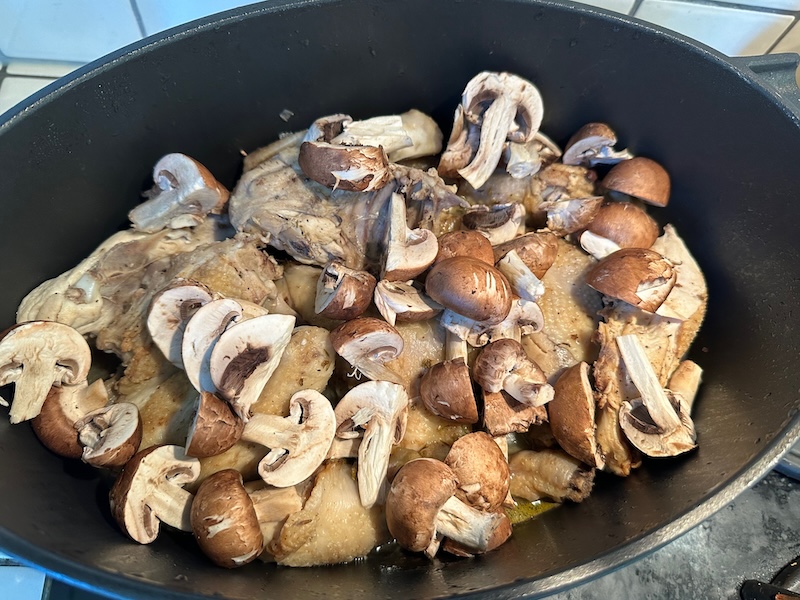
As dinner time approached the following day, I brought the chicken to room temperature before adding the next layer of flavor – from the mushrooms, which I had cleaned and quartered. I scattered them over the chicken, after bringing the casserole again to a simmer, put the lid on and stewed them together for 15 minutes, until the mushrooms were tender.
Theme and Variation
The Normandy dairy products were the final addition. I removed the chicken and mushrooms and put them on a serving platter. Then I whisked an egg yolk together with three tablespoons of crème fraîche; stirred it into the warm gravy; and poured it over the chicken. We ate it with rice and white asparagus as we watched the sun set. The result was sweet, creamy and rich with the flavors of Normandy.
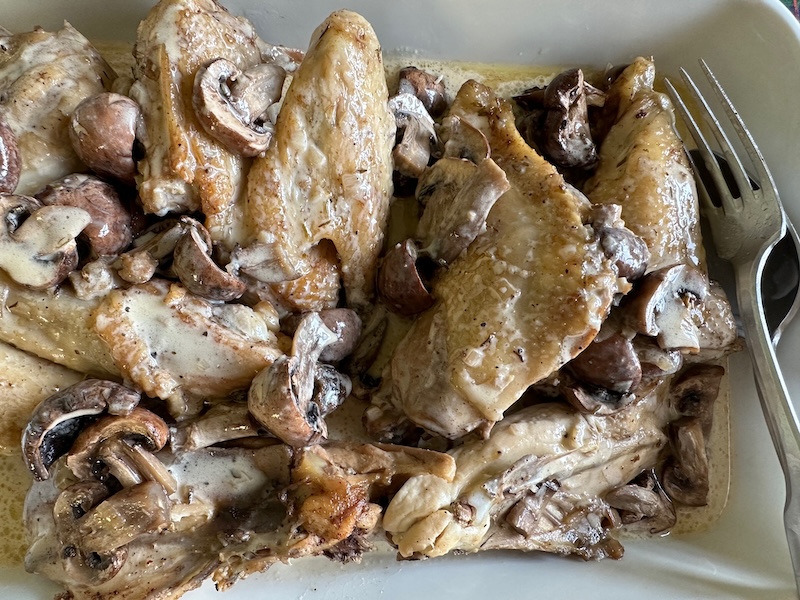
A bit of online research suggests that, as in other regions, no two grandmothers would prepare stewed chicken precisely the same way. Though I like the umami flavor that the mushrooms impart, they aren’t yet plentiful in the markets. When apples are abundant, I might have diced one and sautéed it before adding the shallots. And though I’m partial to this allium, others may prefer leeks or garlic, or omit the herbs. Each rendition will be slightly different.
So it was with the Impressionist painters. On our last day on the Côte Fleurie, we visited the Eugène Boudin Museum in Honfleur, named for the landscape painter who was born there in 1824 and encouraged his contemporaries to paint outdoors. Its permanent collection includes various depictions of the villages where we’d been poking around for the previous week.
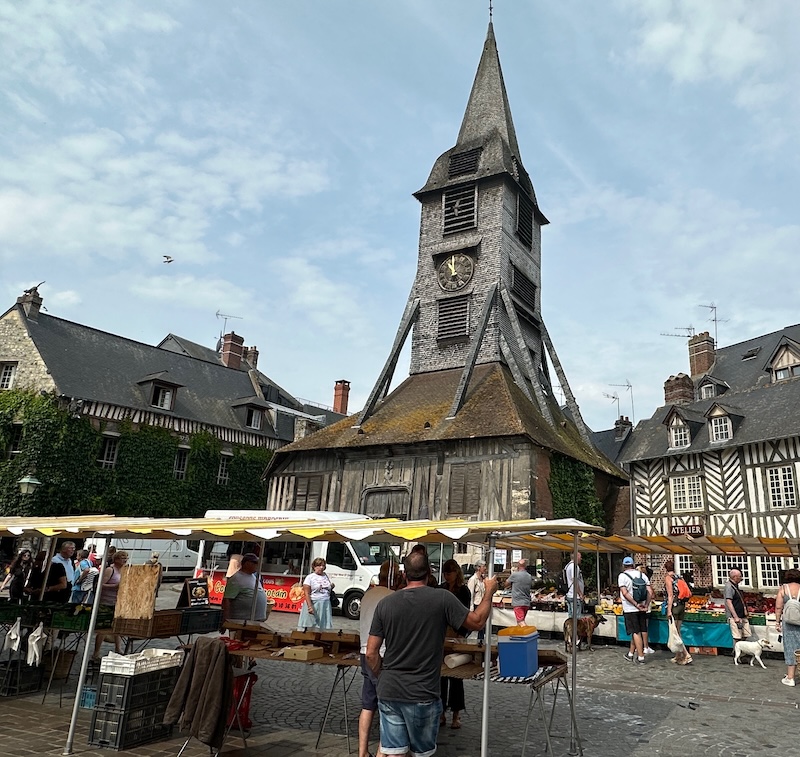
Not surprisingly, the best of this genre tends to be housed elsewhere – for example, at the Musée d’Orsay in Paris, the Tate Gallery in London and the Metropolitan Museum of Art in my home town, New York. But it was still a thrill to see Johan Barthold Jongkind’s painting of the outdoor market in front of the wooden Church of Sainte Catherine. We had shopped there the previous Saturday, negotiating the throngs of tour groups.
“Sunset in Villerville,” by Karl Daubigny, was set in a village that I had never heard of before an Airbnb search led us to rent a house there. Like Daubigny, we had been moved by the drama of the sunset each evening. While it may have taken him weeks to capture it with layers of paint, I recorded it with the click of an iPhone camera app, as my free-range chicken bubbled on low heat.
Deborah L. Jacobs, a lawyer and journalist, is the author of Four Seasons in a Day: Travel, Transitions and Letting Go of the Place We Call Home and Estate Planning Smarts: A Practical, User-Friendly, Action-Oriented Guide. Join her on Facebook here. You can subscribe to future blog posts by using the sign-up box on her website’s homepage.
RELATED POSTS
Eating Like a Grape Picker in Alsace
 Impressionism in the kitchen: Preparing a local recipe that shouldn't be rushed, at an Airbnb rental outside the village of Villerville, France.
Impressionism in the kitchen: Preparing a local recipe that shouldn't be rushed, at an Airbnb rental outside the village of Villerville, France.